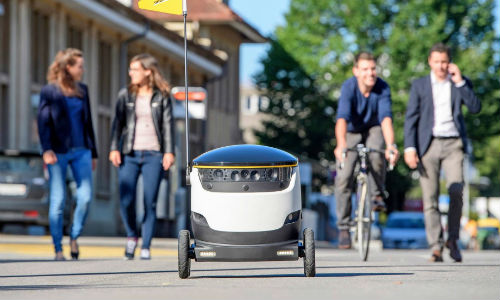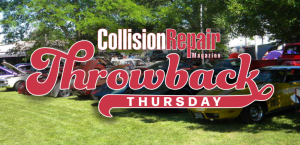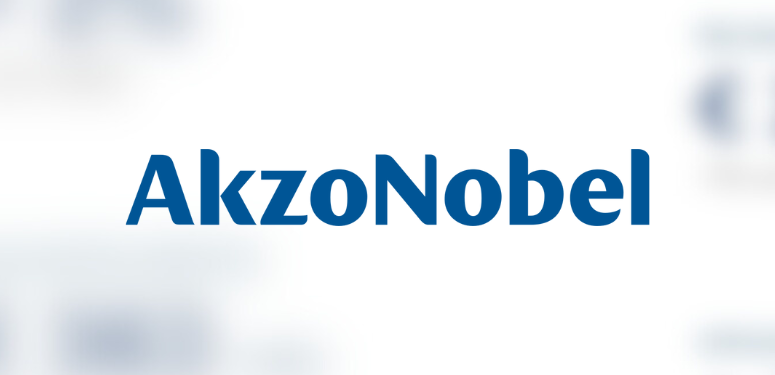By Jeff Sanford
Toronto, Ontario — January 22, 2017 — Here in early 2017 the automated vehicle (AV) story is emerging as a major new business trend. Make sure to keep up with the latest on this new industrial sector each Monday at collisionrepairmag.com. This week we look into Airbus’ plans to test a self-piloted flying car, Velodyne’s investments to ramp up production on LiDAR systems, the Deloitte study that shows very low levels of public trust in AVs and much, much more!
– The CEO of Airbus this week announced plans to test a prototype “self-piloted flying car” by the end of the year according to a report on Business Insider. Airbus has formed a new division, Urban Air Mobility, to handle the mission. The company is hoping to find ways to beat urban traffic by, “… exploring concepts such as a vehicle to transport individuals or a helicopter-style vehicle that can carry multiple riders. The aim would be for people to book the vehicle using an app, similar to car-sharing schemes.”
Airbus CEO Tom Enders was quoted as saying, “One hundred years ago, urban transport went underground, now we have the technological wherewithal to go above ground. We are in an experimentation phase, we take this development very seriously.” The story also quoted Enders as saying that, Airbus, as the world’s largest maker of commercial helicopters, “…wanted to invest to make the most of new technologies such as autonomous driving and artificial intelligence, to usher in what amounts to an era of flying cars.” Said Enders, “If we ignore these developments, we will be pushed out of important segments of the business.”
– Velodyne has announced the opening of what it calls a “Megafactory” that will, “… significantly ramp up production of the latest 3D LiDAR sensors to meet high global demand.” LiDAR is the laser-based radar systems that will be on AVs. The company expects such high demand for these devices that it is expanding its production capability this year. According t a press release, the San Jose, California, facility, “… not only has enough space for high-volume manufacturing, but also for the precise distance and ranging alignment process for LiDAR sensors as they come off the assembly line … more than one million LiDAR sensors [are] expected to be built in the facility in 2018. That high-volume manufacturing will feed the global demand for … the primary and critical instrument needed for autonomous car systems around the world.”
– A report on Forbes notes that, “Online retail behemoth Amazon quietly joined the fray [around AVs] by being granted a patent for communications between autonomous vehicles and roadway management systems.” The patent filed by the retailer involves a method for, “… sharing lane direction and guidance information with self-driving vehicles on roads that have reversible lanes. While the system would seem to deal mainly with on-highway automated vehicles, the proposed system is applicable to ‘any type of vehicle, including but not limited to cars, trucks, vans, buses, street cars, helicopters, trains, subways, aircrafts, boats, etc., regardless of how powered or driven’.” According to the report, “Amazon’s vehicle-to-infrastructure communication system addresses an issue that must be solved before the technology can be deployed, along with helping vehicles merge in traffic and change lanes … The metro Seattle area, Amazon’s home region, has long used reversible highway lanes to ease rush-hour congestion and the technology the retailer has developed ensures that automated vehicles are guided to the appropriate lanes when the change occurs. Automated vehicles using Amazon’s system can also alert the roadway management system of lane changes they plan to make, with a goal of keeping traffic flowing smoothly … Robotic trucks and vans are a logical addition to the company’s evolving logistics strategy.”
– Two neighbourhoods in America will be home to tests of local, small robot delivery vehicles. “A small number of Americans will soon be able to have food and other goods delivered to them by an adorable semi-autonomous robot. Starship Technologies announced the first two commercial partnerships for its ground-based delivery robots in the US today — one with DoorDash in Redwood City, California, and one with Postmates in Washington, DC. The commercial trials will see these services start making deliveries in the coming weeks using Starship’s six-wheeled robots within a four-mile-wide test area in each city.”
According to a write-up on The Verge, “Once an order is placed and the robot delivery method selected, the customers will receive a notification when their delivery is on the way. The robots are capable of carrying up to 20 lbs. of cargo, and their top speed of just four miles per hour means they typically stick to navigating sidewalks.” The robots also have cameras, GPS, built-in alarms, and a two-way radio to deter thefts along the way.
 |
|
| A six-wheeled delivery drone produced by Starship Technologies. The drones will see{source}<br/>{/source} tests conducted in Redwood City, California and Washington, DC in the coming weeks. |
– The emerging hype around AVs is creating an excitement about the stocks of companies in the sector not unlike the excitement around the dot-com stocks of the mid-to-late 90s. The boom of that era made many investors rich. Those in late got fleeced when it all collapsed. But the days on the upside were fantastic. Retail investor-focused website The Motley Fool just published an article about a company, Ambarella. “In July 2015, Ambarella acquired an Italy-based company consisting of 27 engineers called VisLab for $30 million in cash. The privately held VisLab was founded by University of Parma Professor Alberto Broggi and specialized in perception systems and autonomous vehicle research … Computer vision is an area of significant focus for Ambarella, and will be critical to our current video markets, as well as future markets such as automotive OEM cameras.”
Every stock boom needs a backing story. In the days of the dot-com boom it was a story about how the internet was going to make everything perfect. Now it’s about the emergence of AVs and the internet of everything, the point when the computer system are linked, not just to each other, but to the environment itself. Visual recognition. AI. Discernment programs. How to re-cognize dangers. These are the things being coded this time, and it’s kind of an amazing thing. And so says a story about this company that was recently doing something else, basically,” The topic of interest at last week’s conference during Q&A was Ambarella’s plans to possibly compete in the autonomous automotive space with Israeli semiconductor company Mobileye N.V.”
Mobileye had been mentioned before in this space. It’s interesting to note that the company, Ambarella, felt the need to admit in the ad that it, “… does not currently have an SoC for autonomous vehicles.” The pitch goes on to note that, “… the company’s original automotive experience was centered around the aftermarket for dashboard cameras, but in the second half of this fiscal year, it began shipping SoCs directly to automotive OEMs. This is significant in that it helps forge a direct relationship between the automotive companies who are now making electronic mirrors native to vehicles.”
According to the analyst, a company, “… such as Mobileye is richly valued and has numerous agreements with automotive companies around its autonomous driving solutions. Investors are willing to pay up to own shares of Mobileye.”
– Good news for Elon Musk last week. Reuters reported that auto safety regulators found, “… no evidence of defects,” in a Tesla Motors car involved in the death of a man whose Model S collided with a truck. The man’s death in Florida has been called the first auto death of the era of autonomous vehicles. He was using its Autopilot system in 2016 when the devices failed to brake for a truck crossing in front of the car. According to the report, “The case has been closely watched as automakers race to automate more driving tasks without exposing themselves to increased liability risks.”
Is there confusion over who is in control? Legal experts said the agency’s decision does not mean automakers would escape liability claims in cases where driver assistance systems fail to prevent a crash. “If it is known that drivers are misusing and being confused by your self-driving system, then that in and of itself can be a safety-related defect,” product liability lawyer Jason Stephens said. NHTSA issued numerous subpoenas and requests for information to Tesla, and also sought information from Tesla supplier Mobileye. The agency asked Tesla to describe how it monitored misuse of the system and steps it took before introducing the technology to prevent misuse, but nearly all of Tesla’s answers were redacted by the agency. In September Tesla, “… unveiled improvements to Autopilot, adding new limits on hands-off driving and other features that its chief executive officer said likely would have prevented a fatality … The agency also said its decision to close the investigation was not based on the software improvements announced in September.”
– Other good news for Tesla out of the NHTSA report, as reported by The Verge: “Tesla’s crash rate dropped 40 percent after the electric car maker installed its semi-autonomous Autopilot software.” Apparently, “NHTSA analyzed all mileage and airbag deployment data supplied by Tesla for all 2014 through 2016 Model S and 2016 Model X vehicles equipped with Autopilot. The data show that the Tesla vehicles crash rate dropped by almost 40 percent after Autosteer installation.” The report goes on to suggest that while the government, “… concluded that while advanced driver assist systems (ADAS) like Autopilot may help in reducing auto accidents, they should not supplement or replace a driver’s attention to the road. The exact quote from the paper: “While ADAS technologies are continually improving in performance in larger percentages of crash types, a driver should never wait for automatic braking to occur when a collision threat is perceived …”
– Time-lapse photography footage of an AV driving in an urban environment. Note the vehicle, at a stop light, comes to a complete stop much further from the vehicle ahead than does the average human.
– Deloitte has just released a report that finds consumers remain sceptical about the safety of fully autonomous vehicles and, “… hold widely divergent views on who they trust to bring autonomous vehicles to market.” An interesting finding: “Interest in fully autonomous vehicles has risen slightly in China (4 percent) and the U.S. (3 percent) since 2014, but interest has remained flat or declined in the four remaining countries in the report … Trust appears to be the biggest roadblock to selling the notion of self-driving cars in every country surveyed … The U.S. falls roughly in the middle, where nearly three-quarters of consumers (74 percent) believe fully autonomous vehicles will not be safe … More than two-thirds of Americans (68 percent) say they’ll change their opinion with a proven track record for such vehicles and more than half of U.S. drivers (54 percent) say they would ride in an autonomous car if it was offered by a brand they trust.”





































